University Essay: Sustainable Development Goals and Energy Challenges
VerifiedAdded on 2023/05/30
|8
|2045
|90
Essay
AI Summary
This essay provides an overview of the Sustainable Development Goals (SDGs) established by the United Nations for global development. It particularly focuses on the seventh goal, which addresses affordable, reliable, sustainable, and modern energy for all. The essay outlines the targets and indicators associated with the energy goal, including access to electricity, renewable energy share, and energy efficiency improvements. It highlights achievements since 2016, such as increased access to electricity and the growth of renewable energy sources. However, the essay also identifies barriers to achieving these goals, including varying energy policies, lack of energy efficiency focus, challenges in carbon capture, and infrastructure financing issues. The essay concludes by emphasizing the need to overcome these challenges to ensure the successful implementation of the SDGs and achieve sustainable development worldwide.
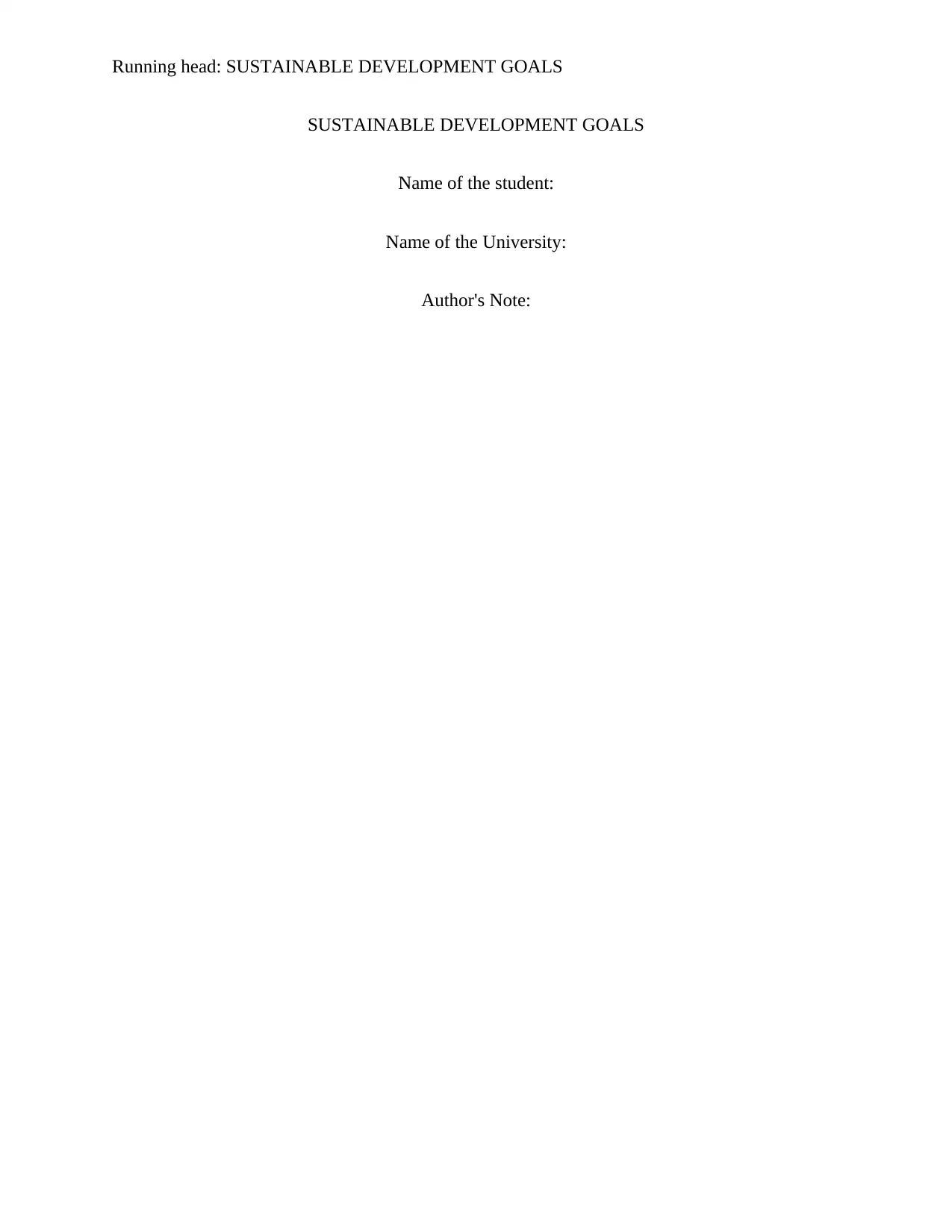
Running head: SUSTAINABLE DEVELOPMENT GOALS
SUSTAINABLE DEVELOPMENT GOALS
Name of the student:
Name of the University:
Author's Note:
SUSTAINABLE DEVELOPMENT GOALS
Name of the student:
Name of the University:
Author's Note:
Paraphrase This Document
Need a fresh take? Get an instant paraphrase of this document with our AI Paraphraser
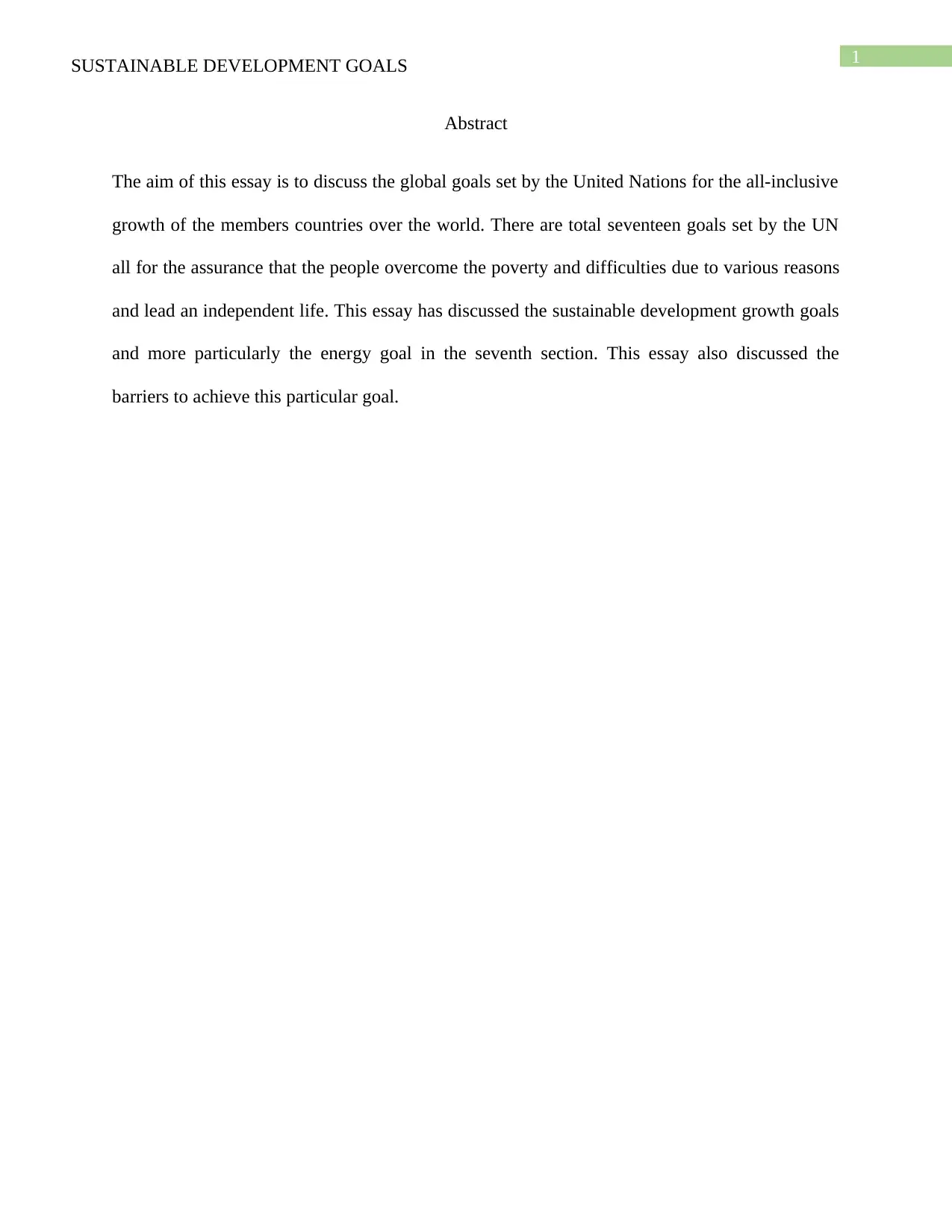
1SUSTAINABLE DEVELOPMENT GOALS
Abstract
The aim of this essay is to discuss the global goals set by the United Nations for the all-inclusive
growth of the members countries over the world. There are total seventeen goals set by the UN
all for the assurance that the people overcome the poverty and difficulties due to various reasons
and lead an independent life. This essay has discussed the sustainable development growth goals
and more particularly the energy goal in the seventh section. This essay also discussed the
barriers to achieve this particular goal.
Abstract
The aim of this essay is to discuss the global goals set by the United Nations for the all-inclusive
growth of the members countries over the world. There are total seventeen goals set by the UN
all for the assurance that the people overcome the poverty and difficulties due to various reasons
and lead an independent life. This essay has discussed the sustainable development growth goals
and more particularly the energy goal in the seventh section. This essay also discussed the
barriers to achieve this particular goal.

2SUSTAINABLE DEVELOPMENT GOALS
The sustainable development goals aim to take actions in the global level to overcome
different type of difficulties in the global communities such as poverty, providing protection to
the planet to ensure that all the people in this world live in peach and prosperity. There are total
17 goals that include bring changes to face global climate change, economic inequality,
sustainable consumption, innovation so that the peace and priorities can be established. All these
goals of the United States are interconnected so that tackling these issues can become easy.
These goals are mainly applicable to the member countries of the world who are funded
effectively to develop infrastructure and all the needed changes to implement transformation and
achieve the goals set by the SDGs.
In the 2030 Agenda for Sustainable Development, the motto adopted was 'Transforming
Our World’. These goals are valid from 1st January 2016 to 31st December 2030. These goals are
applicable for the entire world including the developed and developing countries alike. These
goals are integrated and balance all the three dimensions like economic, environmental and
social dimensions in the sustainable development (Undp.org 2018). Through the largest
consultation program, the UN tries to obtain opinion on what the goals must include. Among the
17 goals, the seventh one refers to the access to affordable, reliable, sustainable and modern
energy for all. With this particular goal the importance of energy is finally being recognized by
the UN. It recognizes energy to be a chief enabler for all inclusive development. The universal
access to energy is an important part of the top international priorities for sustainable growth
(Undp.org 2018). This also include increasing the share top renewable energy which will bring
improvement in the energy efficiency for the sustainable global development.
There are only three divisions in this particular goal with two subdivisions. In 7.1 the
goal refers to create condition so that all the countries get the access to modern, reliable and
The sustainable development goals aim to take actions in the global level to overcome
different type of difficulties in the global communities such as poverty, providing protection to
the planet to ensure that all the people in this world live in peach and prosperity. There are total
17 goals that include bring changes to face global climate change, economic inequality,
sustainable consumption, innovation so that the peace and priorities can be established. All these
goals of the United States are interconnected so that tackling these issues can become easy.
These goals are mainly applicable to the member countries of the world who are funded
effectively to develop infrastructure and all the needed changes to implement transformation and
achieve the goals set by the SDGs.
In the 2030 Agenda for Sustainable Development, the motto adopted was 'Transforming
Our World’. These goals are valid from 1st January 2016 to 31st December 2030. These goals are
applicable for the entire world including the developed and developing countries alike. These
goals are integrated and balance all the three dimensions like economic, environmental and
social dimensions in the sustainable development (Undp.org 2018). Through the largest
consultation program, the UN tries to obtain opinion on what the goals must include. Among the
17 goals, the seventh one refers to the access to affordable, reliable, sustainable and modern
energy for all. With this particular goal the importance of energy is finally being recognized by
the UN. It recognizes energy to be a chief enabler for all inclusive development. The universal
access to energy is an important part of the top international priorities for sustainable growth
(Undp.org 2018). This also include increasing the share top renewable energy which will bring
improvement in the energy efficiency for the sustainable global development.
There are only three divisions in this particular goal with two subdivisions. In 7.1 the
goal refers to create condition so that all the countries get the access to modern, reliable and
⊘ This is a preview!⊘
Do you want full access?
Subscribe today to unlock all pages.

Trusted by 1+ million students worldwide

3SUSTAINABLE DEVELOPMENT GOALS
affordable energy services. This clause has two indicators which include measurement of
percentage of population with perfect access to electricity and building reliance on the cleaner
fuels and technology for a proportion of population (Undp.org 2018). In this regard, the term
clean has been referred to the specific fuel recommendations as well as emission rate targets for
indoor air quality. In the 7.2 clause refers to the increased share of renewable energy
substantially in global energy mix in which the indicator is the renewable energy share in final
energy consumption. In the third clause the goal refers to double the global energy efficiency
improvement rate by 2030. In this regard, the energy intensity through GDP and primary energy.
In addition to these three divisions, there are two subdivisions which refers to the
improvement in international cooperation for facilitating access to clean energy technology and
research that includes renewable energy, efficiency and advanced yet cleaner energy. This also
promotes investment in the energy infrastructure as well as cleaner energy technology within
2030 (Undp.org 2018). The other subdivision of the 7th goal refers to the expansion of
infrastructure as well as upgradation of technology for supplying modern as well as sustainable
energy services for all the developing countries especially for the least developed countries, land
locked countries, small islands or developing states in the world so that these countries can gain
support from this program (Undp.org 2018). The indicators of development process will be the
GDP percentage and the foreign direct investment for the infrastructure as well as technology for
sustainable development services.
According to the experts like Griggs et al. (2013), this goal 7 of SDGs, though mainly
deals with the energy, can relate to achieve the that goals. This due to the fact that this particular
goal will contribute the achieve energy access, energy efficiency, renewable energy and all the
other energy related issues hence can help to achieve other goals simultaneously. Since 2016,
affordable energy services. This clause has two indicators which include measurement of
percentage of population with perfect access to electricity and building reliance on the cleaner
fuels and technology for a proportion of population (Undp.org 2018). In this regard, the term
clean has been referred to the specific fuel recommendations as well as emission rate targets for
indoor air quality. In the 7.2 clause refers to the increased share of renewable energy
substantially in global energy mix in which the indicator is the renewable energy share in final
energy consumption. In the third clause the goal refers to double the global energy efficiency
improvement rate by 2030. In this regard, the energy intensity through GDP and primary energy.
In addition to these three divisions, there are two subdivisions which refers to the
improvement in international cooperation for facilitating access to clean energy technology and
research that includes renewable energy, efficiency and advanced yet cleaner energy. This also
promotes investment in the energy infrastructure as well as cleaner energy technology within
2030 (Undp.org 2018). The other subdivision of the 7th goal refers to the expansion of
infrastructure as well as upgradation of technology for supplying modern as well as sustainable
energy services for all the developing countries especially for the least developed countries, land
locked countries, small islands or developing states in the world so that these countries can gain
support from this program (Undp.org 2018). The indicators of development process will be the
GDP percentage and the foreign direct investment for the infrastructure as well as technology for
sustainable development services.
According to the experts like Griggs et al. (2013), this goal 7 of SDGs, though mainly
deals with the energy, can relate to achieve the that goals. This due to the fact that this particular
goal will contribute the achieve energy access, energy efficiency, renewable energy and all the
other energy related issues hence can help to achieve other goals simultaneously. Since 2016,
Paraphrase This Document
Need a fresh take? Get an instant paraphrase of this document with our AI Paraphraser
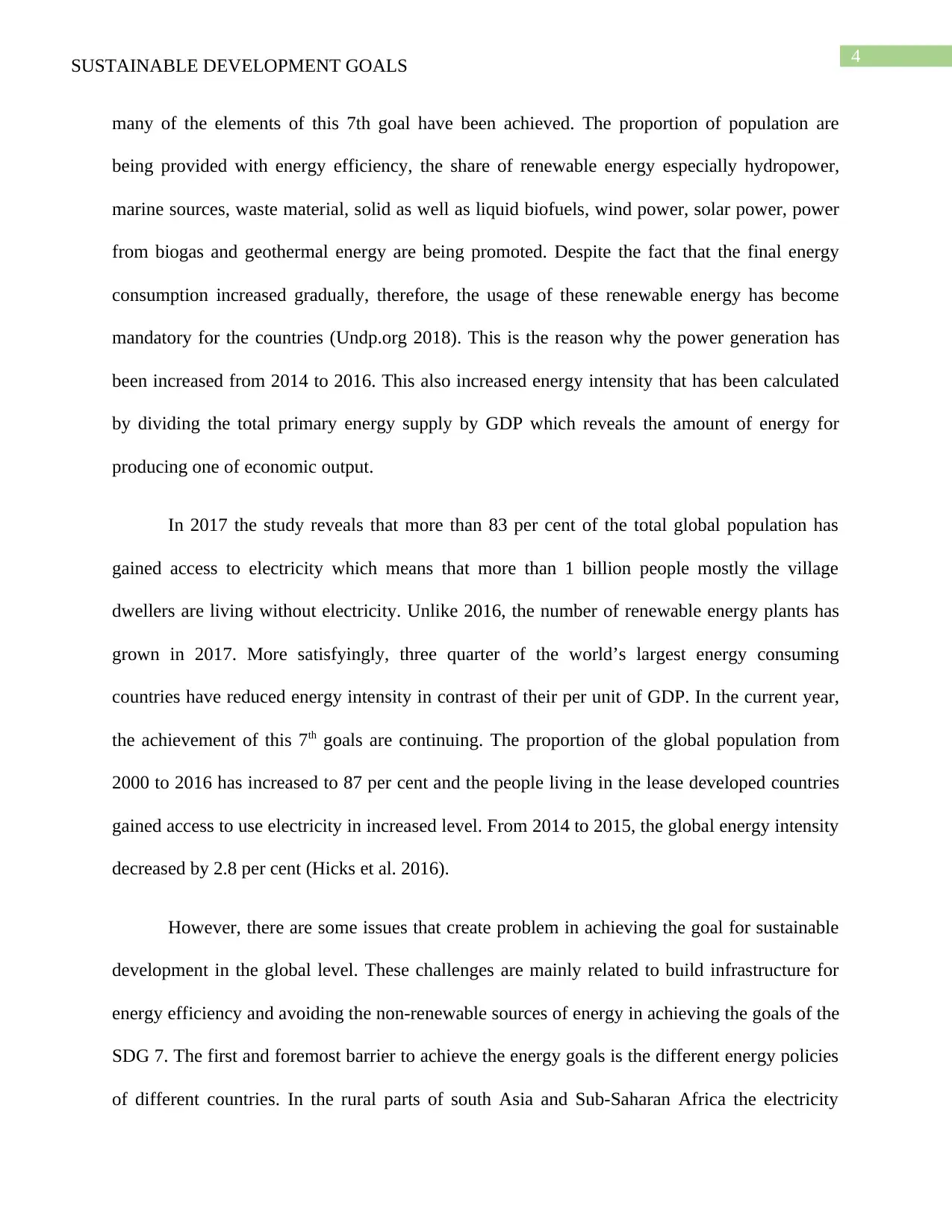
4SUSTAINABLE DEVELOPMENT GOALS
many of the elements of this 7th goal have been achieved. The proportion of population are
being provided with energy efficiency, the share of renewable energy especially hydropower,
marine sources, waste material, solid as well as liquid biofuels, wind power, solar power, power
from biogas and geothermal energy are being promoted. Despite the fact that the final energy
consumption increased gradually, therefore, the usage of these renewable energy has become
mandatory for the countries (Undp.org 2018). This is the reason why the power generation has
been increased from 2014 to 2016. This also increased energy intensity that has been calculated
by dividing the total primary energy supply by GDP which reveals the amount of energy for
producing one of economic output.
In 2017 the study reveals that more than 83 per cent of the total global population has
gained access to electricity which means that more than 1 billion people mostly the village
dwellers are living without electricity. Unlike 2016, the number of renewable energy plants has
grown in 2017. More satisfyingly, three quarter of the world’s largest energy consuming
countries have reduced energy intensity in contrast of their per unit of GDP. In the current year,
the achievement of this 7th goals are continuing. The proportion of the global population from
2000 to 2016 has increased to 87 per cent and the people living in the lease developed countries
gained access to use electricity in increased level. From 2014 to 2015, the global energy intensity
decreased by 2.8 per cent (Hicks et al. 2016).
However, there are some issues that create problem in achieving the goal for sustainable
development in the global level. These challenges are mainly related to build infrastructure for
energy efficiency and avoiding the non-renewable sources of energy in achieving the goals of the
SDG 7. The first and foremost barrier to achieve the energy goals is the different energy policies
of different countries. In the rural parts of south Asia and Sub-Saharan Africa the electricity
many of the elements of this 7th goal have been achieved. The proportion of population are
being provided with energy efficiency, the share of renewable energy especially hydropower,
marine sources, waste material, solid as well as liquid biofuels, wind power, solar power, power
from biogas and geothermal energy are being promoted. Despite the fact that the final energy
consumption increased gradually, therefore, the usage of these renewable energy has become
mandatory for the countries (Undp.org 2018). This is the reason why the power generation has
been increased from 2014 to 2016. This also increased energy intensity that has been calculated
by dividing the total primary energy supply by GDP which reveals the amount of energy for
producing one of economic output.
In 2017 the study reveals that more than 83 per cent of the total global population has
gained access to electricity which means that more than 1 billion people mostly the village
dwellers are living without electricity. Unlike 2016, the number of renewable energy plants has
grown in 2017. More satisfyingly, three quarter of the world’s largest energy consuming
countries have reduced energy intensity in contrast of their per unit of GDP. In the current year,
the achievement of this 7th goals are continuing. The proportion of the global population from
2000 to 2016 has increased to 87 per cent and the people living in the lease developed countries
gained access to use electricity in increased level. From 2014 to 2015, the global energy intensity
decreased by 2.8 per cent (Hicks et al. 2016).
However, there are some issues that create problem in achieving the goal for sustainable
development in the global level. These challenges are mainly related to build infrastructure for
energy efficiency and avoiding the non-renewable sources of energy in achieving the goals of the
SDG 7. The first and foremost barrier to achieve the energy goals is the different energy policies
of different countries. In the rural parts of south Asia and Sub-Saharan Africa the electricity
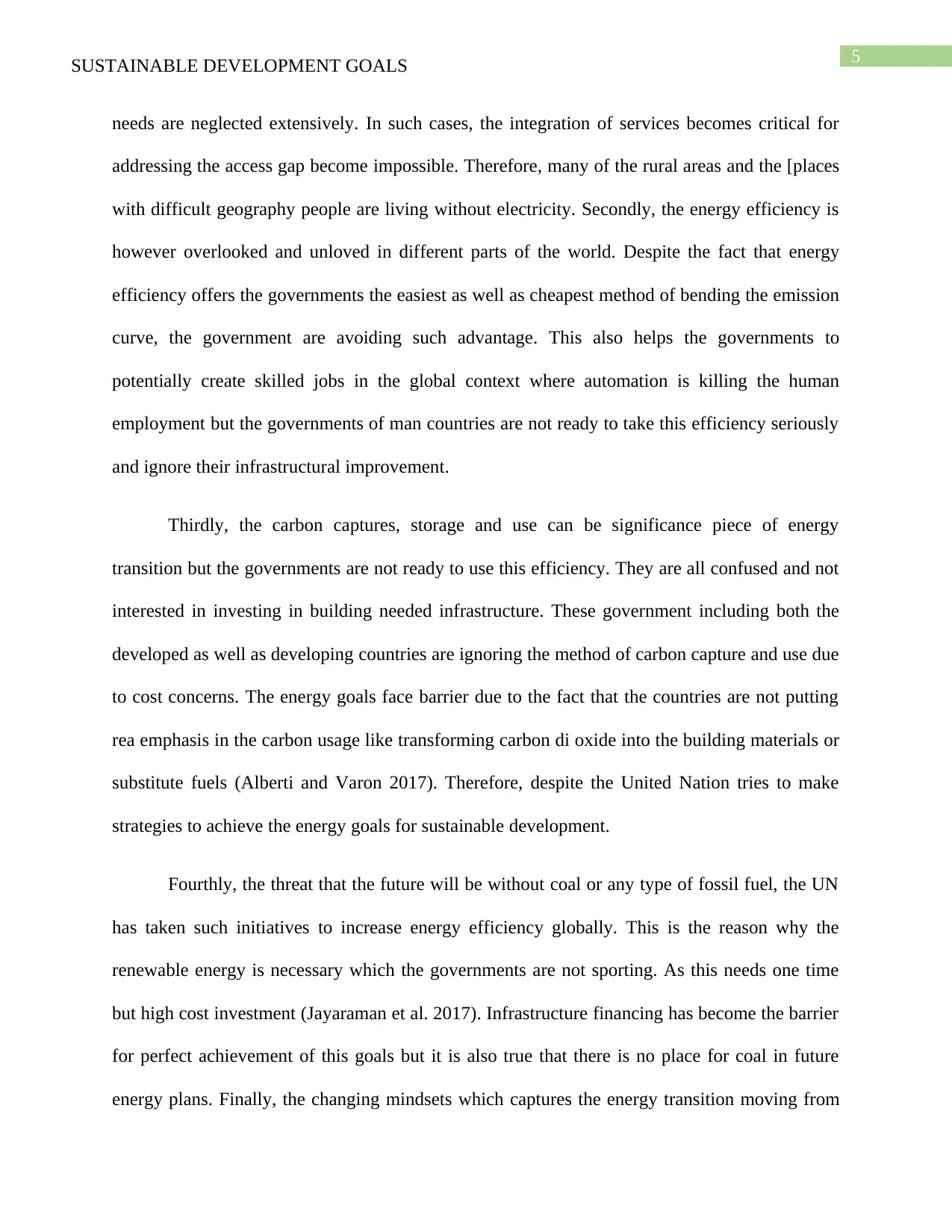
5SUSTAINABLE DEVELOPMENT GOALS
needs are neglected extensively. In such cases, the integration of services becomes critical for
addressing the access gap become impossible. Therefore, many of the rural areas and the [places
with difficult geography people are living without electricity. Secondly, the energy efficiency is
however overlooked and unloved in different parts of the world. Despite the fact that energy
efficiency offers the governments the easiest as well as cheapest method of bending the emission
curve, the government are avoiding such advantage. This also helps the governments to
potentially create skilled jobs in the global context where automation is killing the human
employment but the governments of man countries are not ready to take this efficiency seriously
and ignore their infrastructural improvement.
Thirdly, the carbon captures, storage and use can be significance piece of energy
transition but the governments are not ready to use this efficiency. They are all confused and not
interested in investing in building needed infrastructure. These government including both the
developed as well as developing countries are ignoring the method of carbon capture and use due
to cost concerns. The energy goals face barrier due to the fact that the countries are not putting
rea emphasis in the carbon usage like transforming carbon di oxide into the building materials or
substitute fuels (Alberti and Varon 2017). Therefore, despite the United Nation tries to make
strategies to achieve the energy goals for sustainable development.
Fourthly, the threat that the future will be without coal or any type of fossil fuel, the UN
has taken such initiatives to increase energy efficiency globally. This is the reason why the
renewable energy is necessary which the governments are not sporting. As this needs one time
but high cost investment (Jayaraman et al. 2017). Infrastructure financing has become the barrier
for perfect achievement of this goals but it is also true that there is no place for coal in future
energy plans. Finally, the changing mindsets which captures the energy transition moving from
needs are neglected extensively. In such cases, the integration of services becomes critical for
addressing the access gap become impossible. Therefore, many of the rural areas and the [places
with difficult geography people are living without electricity. Secondly, the energy efficiency is
however overlooked and unloved in different parts of the world. Despite the fact that energy
efficiency offers the governments the easiest as well as cheapest method of bending the emission
curve, the government are avoiding such advantage. This also helps the governments to
potentially create skilled jobs in the global context where automation is killing the human
employment but the governments of man countries are not ready to take this efficiency seriously
and ignore their infrastructural improvement.
Thirdly, the carbon captures, storage and use can be significance piece of energy
transition but the governments are not ready to use this efficiency. They are all confused and not
interested in investing in building needed infrastructure. These government including both the
developed as well as developing countries are ignoring the method of carbon capture and use due
to cost concerns. The energy goals face barrier due to the fact that the countries are not putting
rea emphasis in the carbon usage like transforming carbon di oxide into the building materials or
substitute fuels (Alberti and Varon 2017). Therefore, despite the United Nation tries to make
strategies to achieve the energy goals for sustainable development.
Fourthly, the threat that the future will be without coal or any type of fossil fuel, the UN
has taken such initiatives to increase energy efficiency globally. This is the reason why the
renewable energy is necessary which the governments are not sporting. As this needs one time
but high cost investment (Jayaraman et al. 2017). Infrastructure financing has become the barrier
for perfect achievement of this goals but it is also true that there is no place for coal in future
energy plans. Finally, the changing mindsets which captures the energy transition moving from
⊘ This is a preview!⊘
Do you want full access?
Subscribe today to unlock all pages.

Trusted by 1+ million students worldwide

6SUSTAINABLE DEVELOPMENT GOALS
static as well as centralized energy systems running on fossil fuel to the integrated systems of
energy efficiency. However, this terrifying in the old energy system especially for the regulators
ad the institutional managers. therefore, the member countries of UN are finding the achievement
of the targets of the sustainable development agenda to be difficult.
Therefore, it can be concluded that the UN on behalf of the countries in the world have
taken initiative to ser targets to achieve goals for sustainable development. The seventh goal in
this section aims to increase reach of the energy distribution in all over the places of the world
and to the increased share of renewable energy substantially in global energy mix in which the
indicator is the renewable energy share in final energy consumption. There are some barriers
which need to be overcome with time and support of the member countries which are ignoring
the method of carbon capture and use due to cost concerns
static as well as centralized energy systems running on fossil fuel to the integrated systems of
energy efficiency. However, this terrifying in the old energy system especially for the regulators
ad the institutional managers. therefore, the member countries of UN are finding the achievement
of the targets of the sustainable development agenda to be difficult.
Therefore, it can be concluded that the UN on behalf of the countries in the world have
taken initiative to ser targets to achieve goals for sustainable development. The seventh goal in
this section aims to increase reach of the energy distribution in all over the places of the world
and to the increased share of renewable energy substantially in global energy mix in which the
indicator is the renewable energy share in final energy consumption. There are some barriers
which need to be overcome with time and support of the member countries which are ignoring
the method of carbon capture and use due to cost concerns
Paraphrase This Document
Need a fresh take? Get an instant paraphrase of this document with our AI Paraphraser
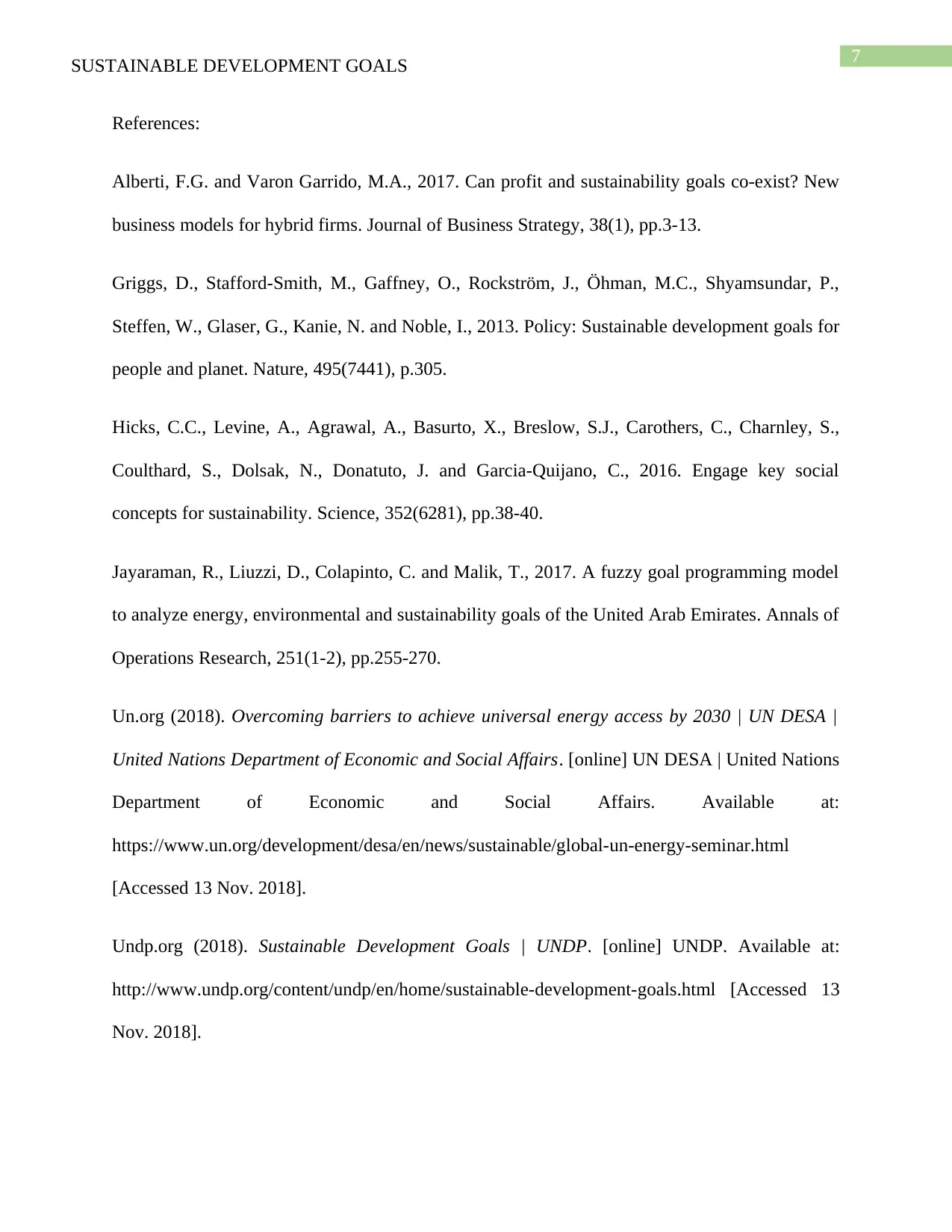
7SUSTAINABLE DEVELOPMENT GOALS
References:
Alberti, F.G. and Varon Garrido, M.A., 2017. Can profit and sustainability goals co-exist? New
business models for hybrid firms. Journal of Business Strategy, 38(1), pp.3-13.
Griggs, D., Stafford-Smith, M., Gaffney, O., Rockström, J., Öhman, M.C., Shyamsundar, P.,
Steffen, W., Glaser, G., Kanie, N. and Noble, I., 2013. Policy: Sustainable development goals for
people and planet. Nature, 495(7441), p.305.
Hicks, C.C., Levine, A., Agrawal, A., Basurto, X., Breslow, S.J., Carothers, C., Charnley, S.,
Coulthard, S., Dolsak, N., Donatuto, J. and Garcia-Quijano, C., 2016. Engage key social
concepts for sustainability. Science, 352(6281), pp.38-40.
Jayaraman, R., Liuzzi, D., Colapinto, C. and Malik, T., 2017. A fuzzy goal programming model
to analyze energy, environmental and sustainability goals of the United Arab Emirates. Annals of
Operations Research, 251(1-2), pp.255-270.
Un.org (2018). Overcoming barriers to achieve universal energy access by 2030 | UN DESA |
United Nations Department of Economic and Social Affairs. [online] UN DESA | United Nations
Department of Economic and Social Affairs. Available at:
https://www.un.org/development/desa/en/news/sustainable/global-un-energy-seminar.html
[Accessed 13 Nov. 2018].
Undp.org (2018). Sustainable Development Goals | UNDP. [online] UNDP. Available at:
http://www.undp.org/content/undp/en/home/sustainable-development-goals.html [Accessed 13
Nov. 2018].
References:
Alberti, F.G. and Varon Garrido, M.A., 2017. Can profit and sustainability goals co-exist? New
business models for hybrid firms. Journal of Business Strategy, 38(1), pp.3-13.
Griggs, D., Stafford-Smith, M., Gaffney, O., Rockström, J., Öhman, M.C., Shyamsundar, P.,
Steffen, W., Glaser, G., Kanie, N. and Noble, I., 2013. Policy: Sustainable development goals for
people and planet. Nature, 495(7441), p.305.
Hicks, C.C., Levine, A., Agrawal, A., Basurto, X., Breslow, S.J., Carothers, C., Charnley, S.,
Coulthard, S., Dolsak, N., Donatuto, J. and Garcia-Quijano, C., 2016. Engage key social
concepts for sustainability. Science, 352(6281), pp.38-40.
Jayaraman, R., Liuzzi, D., Colapinto, C. and Malik, T., 2017. A fuzzy goal programming model
to analyze energy, environmental and sustainability goals of the United Arab Emirates. Annals of
Operations Research, 251(1-2), pp.255-270.
Un.org (2018). Overcoming barriers to achieve universal energy access by 2030 | UN DESA |
United Nations Department of Economic and Social Affairs. [online] UN DESA | United Nations
Department of Economic and Social Affairs. Available at:
https://www.un.org/development/desa/en/news/sustainable/global-un-energy-seminar.html
[Accessed 13 Nov. 2018].
Undp.org (2018). Sustainable Development Goals | UNDP. [online] UNDP. Available at:
http://www.undp.org/content/undp/en/home/sustainable-development-goals.html [Accessed 13
Nov. 2018].
1 out of 8
Related Documents
Your All-in-One AI-Powered Toolkit for Academic Success.
+13062052269
info@desklib.com
Available 24*7 on WhatsApp / Email
![[object Object]](/_next/static/media/star-bottom.7253800d.svg)
Unlock your academic potential
Copyright © 2020–2025 A2Z Services. All Rights Reserved. Developed and managed by ZUCOL.




